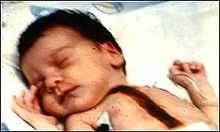Baby Fae

Stephanie Fae Beauclair[1] (October 14, 1984 – November 15, 1984), better known as Baby Fae, was an American infant born in 1984 with hypoplastic left heart syndrome. She became the first infant subject of a xenotransplant procedure, receiving the heart of a baboon. The procedure, performed by Leonard L. Bailey at Loma Linda University Medical Center, was successful, but Fae died 21 days later of heart failure due to rejection of the transplant. The rejection is thought to have been caused largely by a humoral response against the graft, due to Fae's type O blood creating antibodies against the type AB xenograft.[2] The blood type incompatibility was seen as unavoidable: fewer than 1% of baboons are type O, and Loma Linda only had seven young female baboons – all of which were type AB – available as potential donors. It was hoped that the transplant could be replaced by an allograft at a later date, before Fae's body began generating isohaemagglutinins, but a suitable donor could not be found in time. The procedure was subject to a wide ethical and legal debate, but the attention that it generated is thought to have paved the way for Bailey to perform the first successful infant allograft heart transplant a year later.
The Baby Fae case, and Bailey's role in it, has been a popular case study in the realm of medical ethics. Bailey did not look for a human heart for Fae. There were questions as to whether parents should be allowed to volunteer children for experimental medical procedures, and whether the parents themselves were properly informed by Bailey. However, because Fae's mother had no medical insurance, she could not afford to pay for the heart transplant procedure. The xenograft, on the other hand, was offered for free. When asked why he had picked a baboon over a primate more closely related to humans in evolution, he replied "Er, I find that difficult to answer. You see, I don't believe in evolution."[3] Charles Krauthammer, writing in Time, said the Baby Fae case was totally within the realm of experimentation and was "an adventure in medical ethics."[4] Ultimately, the American Medical Association and top medical journals criticized Bailey, concluding that xenografts should be undertaken only as part of a systematic research program with controls in randomized clinical trials.[3]
Although Fae's full name was not made public at the time of the procedure, her mother chose to reveal herself in 1997.[5]
The Paul Simon song "The Boy in the Bubble" from the 1986 Graceland album, most likely references her in the lyrics. "Medicine is magical and magical is art / Thinking of the Boy in the Bubble / And the baby with the baboon heart"
References
- ↑ The Legacy of Baby Fae, at Loma Linda University; published no later than October 2009; retrieved August 16, 2014
- ↑ Bailey, Leonard; Nehlsen-Cannarella SL; Concepcion W; Jolley WB. (December 1985). "Baboon-to-human cardiac xenotransplantation in a neonate.". The Journal of the American Medical Association. 3321-9. 254 (23): 3321–9. doi:10.1001/jama.1985.03360230053022. PMID 2933538.
- ↑ 3.0 3.1 Pence, Gregory E. (2008). Classic Cases in Medical Ethics (5th ed.). Retrieved May 28, 2013.
- ↑ Charles Krauthammer, Essay: The Using of Baby Fae, Time, December 3, 1984, accessed May 28, 2013.
- ↑ "Four Corners - 8/25/1997: Animal Transplants. Australian Broadcasting Corp". Abc.net.au. Retrieved 2008-11-26.
Sources
- Adventist news Network 25th-anniversary retrospective - http://news.adventist.org/2009/10/surgeon-bailey-refle.html
- Contemporary Time Magazine coverage - http://www.time.com/time/magazine/article/0,9171,926947,00.html
- Emmy Award-winning documentary "Stephanie's Heart: The Story of Baby Fae" in two parts -http://www.youtube.com/watch?v=_wAJ6-fSD-Y
- "Baboon-to-human cardiac xenotransplantation in a neonate", from the Journal of the American Medical Association PubMed
External links
| ||||||||||||||||||